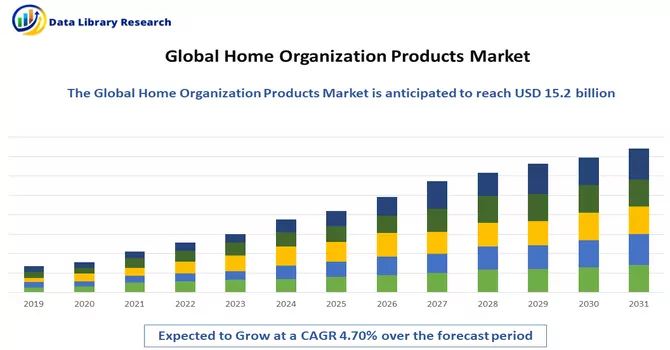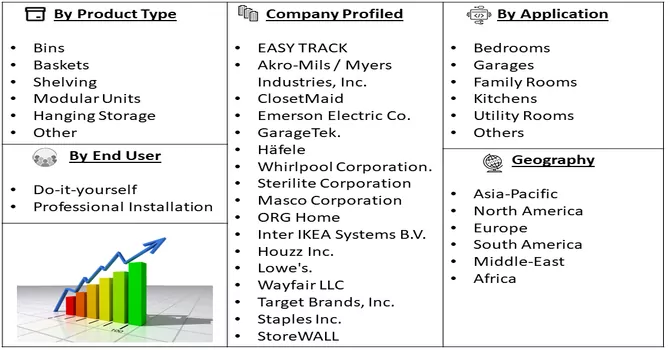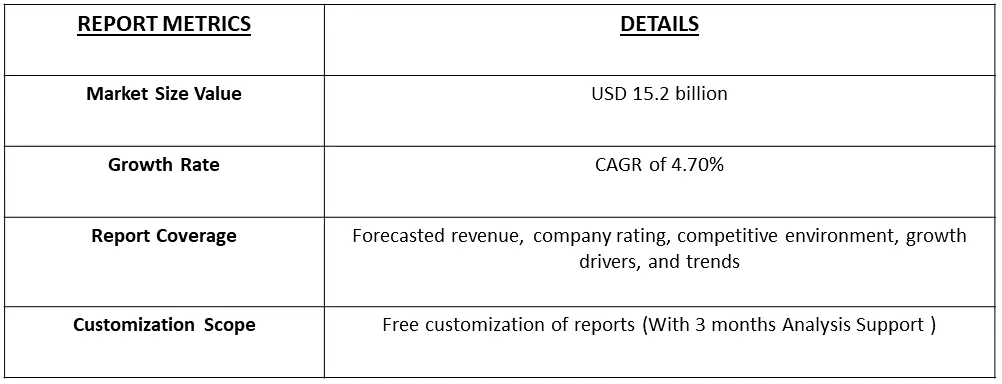The home organization products market is currently valued at USD 15.2 billion in the year 2023 and is expected to be growing at a growth rate of 4.70% in the forecast period of 2024-2031.

Get Complete Analysis Of The Report - Download Free Sample PDF
Home organization products encompass a diverse range of items designed to streamline and optimize the arrangement and storage of belongings within a household. These products include storage bins and baskets in various sizes and materials, modular or fixed shelving systems for books and decor, closet organizers with shelves, drawers, and accessories, as well as drawer organizers to compartmentalize and tidy up drawers. Specialized hangers for clothes, cabinet and pantry organizers like pull-out shelves and spice racks, and storage bags with vacuum seal options contribute to efficient space utilization. Hooks, racks, and labelling systems help organize items like keys, coats, and towels, while furniture with built-in storage, such as ottomans and coffee tables, adds functionality. Cable management solutions minimize visual clutter, and garage organization products cater to tools and sports equipment. These products collectively aim to enhance storage efficiency, reduce clutter, and create a more organized and aesthetically pleasing living space.
The burgeoning trend of remote work is poised to fuel the demand for the home organization products market. The escalating number of households, coupled with an increase in disposable income, serves as a pivotal factor propelling the market for home organization products. Factors such as heightened awareness, growing consumer acceptance, and evolving lifestyles are set to expedite the market's growth trajectory. Moreover, a surge in robust demand across various end-use industries is expected to positively influence the market's expansion. The burgeoning home installations business and a rise in the number of families further contribute to cushioning the growth rate of the market. Additionally, the increasing adoption of specialized and customized products is anticipated to amplify the demand for home organization products in the market.
The home organization products market is undergoing transformative trends driven by shifts in consumer behaviour and lifestyle choices. Notably, the rise of remote work has spurred a heightened demand for products that optimize home office spaces, reflecting the evolving needs of individuals working from home. Concurrently, the increasing number of households, coupled with a rise in disposable income, has fueled a growing interest in storage solutions, shelving systems, and organizational products designed to enhance living spaces. The awareness of the benefits of an organized home is on the upswing, influencing consumer purchasing decisions. Changing lifestyles, characterized by a preference for convenience and efficiency, are driving the demand for innovative and multifunctional organizational products, including modular furniture and smart storage solutions.
Market Segmentation: The Global Home Organization Products Market, by Product Type (Bins, Baskets, Shelving, Modular Units, Hanging Storage, Other), Application (Bedrooms, Garages, Family Rooms, Kitchens, Utility Rooms, Others), End User (Do-it-yourself, and Professional Installation), and Geography (North America, Europe, Asia-Pacific, Middle East and Africa, and South America). The market size and forecasts are provided in terms of value (in USD million) for the above segments.

For Detailed Market Segmentation - Download Free Sample PDF
Market Drivers:
The Increasing Acceptance of Specialized and Customized Home Organization Products
The Global Home Organization Products Market is undergoing a transformative shift as consumers increasingly embrace specialized and customized solutions for optimizing their living spaces. This departure from generic, one-size-fits-all products is evident in the growing demand for personalized items, ranging from custom-designed closet organizers and modular shelving systems to storage solutions tailored to specific rooms. This trend reflects the diverse and evolving needs of consumers, who not only seek functional storage solutions but also desire products that seamlessly integrate with their home's existing décor and align with their personal style preferences. The trend is global in nature, with manufacturers recognizing the importance of catering to a broad range of consumer tastes, regional design preferences, and cultural considerations. As a result, the market is witnessing a surge in innovative and customizable offerings on an international scale, shaping the future landscape of the home organization products market with a focus on individualized solutions that enhance both functionality and aesthetics.
Increasing Trend of Remote Work has Significantly Influenced the Demand for Home Organization Products
The burgeoning trend of remote work has emerged as a pivotal force shaping the Global Home Organization Products Market, significantly influencing the demand for organizational solutions. As an increasing number of individuals embrace flexible work arrangements, there is a growing need for products that cater specifically to the challenges and requirements of remote work, such as specialized storage solutions, cable management systems, and ergonomic furniture for efficient home office spaces. This transformative trend reflects the evolving nature of work environments, where the home now serves as a multifunctional space for both work and leisure, driving the market to introduce innovative products that contribute to overall organization and productivity. This trend is not confined by geographical boundaries but resonates globally, prompting manufacturers to develop and market products tailored to the needs of a diverse and widespread remote workforce. In essence, the increasing prevalence of remote work is reshaping the demand for home organization products, leading to a surge in solutions that cater to the unique organizational needs of a global workforce adapting to the new dynamics of work from home.
Market Restraints:
The Economic Uncertainty and Fluctuations
The Global Home Organization Products Market faces potential challenges stemming from economic uncertainty and fluctuations that could potentially slow its growth trajectory. Periods of economic instability, such as recessions or financial downturns, tend to impact consumer confidence and disposable income, leading individuals to reevaluate their spending priorities. In such circumstances, consumers may be more inclined to prioritize essential purchases over non-essential items like home organization products. The demand for these products is closely tied to consumer discretionary spending, making the market vulnerable to fluctuations in economic conditions. Additionally, during economic downturns, consumers may opt for more cost-conscious choices or delay non-essential purchases altogether, affecting sales and market growth. To navigate these challenges, businesses in the home organization products market may need to adapt their strategies, focusing on value propositions, competitive pricing, and innovative solutions to remain resilient in the face of economic uncertainties.
The COVID-19 pandemic has profoundly impacted the Global Home Organization Products Market, introducing a complex interplay of challenges and opportunities. With lockdowns and remote work becoming the norm, there has been an upsurge in demand for home organization products, particularly those tailored to home office spaces. However, economic uncertainties stemming from the pandemic have influenced consumer spending habits, leading to a more cautious approach to non-essential purchases, which includes home organization products. Supply chain disruptions have also affected manufacturing, distribution, and retail operations. The pandemic has accelerated trends such as the growing significance of e-commerce, prompting manufacturers and retailers to enhance their online presence. Sustainability has gained prominence as consumers exhibit an increased preference for eco-friendly organizational products. The industry's ability to navigate these challenges, embrace digital trends, and meet evolving consumer preferences will be instrumental in determining its resilience and future growth in the post-pandemic era.
Segmental Analysis:
Modular Units Segment is Expected to Witness Significant Growth Over the Forecast Period
Modular units have emerged as versatile and innovative solutions within the home organization product market. These customizable and adaptable systems offer homeowners the flexibility to create tailored storage solutions that cater to their unique needs and living spaces. Whether it's modular shelving units, closet organizers, or modular furniture with built-in storage, these products provide a dynamic and efficient way to optimize space. With the ability to be reconfigured or expanded based on changing requirements, modular units enhance organization and decluttering efforts, contributing to a more organized and aesthetically pleasing home environment. The modular approach aligns with the contemporary demand for flexibility and personalization in home organization, offering a practical and stylish solution for individuals seeking adaptive storage solutions in various rooms of their homes.
Kitchen Segment is Expected to Witness Significant Growth Over the Forecast Period
The kitchen stands as the heart of a home, and the demand for effective home organization products in this vital space has grown significantly. Kitchen organization products play a crucial role in optimizing storage, enhancing functionality, and maintaining a clutter-free environment. From modular cabinet organizers and pull-out pantry shelves to drawer dividers and spice racks, the market offers a diverse range of solutions designed to maximize space utilization and simplify daily tasks. Innovative storage containers, stackable organizers, and under-cabinet storage systems further contribute to creating an efficient and well-organized kitchen. With the rise of open-concept kitchens and the increasing popularity of cooking at home, the demand for stylish and practical kitchen organization products has surged. These products not only streamline daily routines but also add aesthetic value to the kitchen space. As consumers prioritize a well-organized and visually appealing kitchen, manufacturers continue to introduce innovative solutions that cater to the evolving needs of modern households, reflecting the intersection of functionality and design in the realm of home organization products. Thus, the segment is expected to witness significant growth over the forecast period
Do it Yourself Segment is Expected to Witness Significant Growth Over the Forecast Period
The "Do It Yourself" (DIY) ethos has become increasingly intertwined with the home organization product market, offering consumers the opportunity to take an active role in optimizing their living spaces. DIY home organization products empower individuals to personalize and customize their storage solutions, allowing for a more tailored and budget-friendly approach to organization. From easy-to-assemble modular shelving units and customizable closet systems to adhesive hooks and storage bins, the market provides a plethora of DIY options. These products cater to a wide range of skill levels, enabling consumers to embark on organization projects without the need for professional installation. The DIY trend aligns with the desire for hands-on involvement in home improvement and organization, providing a sense of accomplishment and personalization. It caters to those seeking practical and creative solutions to declutter and enhance their living spaces independently. As the DIY movement continues to gain momentum, manufacturers are increasingly focusing on delivering user-friendly and versatile home organization products, empowering consumers to transform their homes into organized, functional, and uniquely curated spaces.
North America Region Segment is Expected to Witness Significant Growth Over the Forecast Period
In North America, the market for home organization products is booming as people increasingly seek practical and stylish solutions to enhance their living spaces. This trend is driven by factors such as the growing number of individuals working from home, the preference for smaller living spaces, and the importance placed on aesthetics in home design. From modular storage units and closet organizers to kitchen and garage storage solutions, the market offers a diverse range of products tailored to meet the unique needs of North American consumers. Consumers in the region prioritize functionality, style, and customization, contributing to the popularity of modular and customizable home organization products. The emphasis on sustainability is also noteworthy, with eco-friendly and durable options gaining favour among environmentally-conscious individuals. E-commerce platforms play a crucial role, providing convenient access for consumers to explore, compare, and purchase organizational products online. In response to consumer demands, manufacturers in North America are continuously innovating, introducing smart storage solutions and aesthetically pleasing designs that seamlessly integrate with modern home aesthetics. As the desire for organized living spaces persists, the North American home organization product market is set for sustained growth, with consumers seeking efficient and stylish solutions to enhance the functionality and beauty of their homes. Thus, such factors are expected to drive the growth of the studied market over the forecast period.

Get Complete Analysis Of The Report - Download Free Sample PDF
The competitive landscape of the home organization products market offers comprehensive insights into each competitor, encompassing key details such as company overview, financials, revenue generation, market potential, investments in research and development, initiatives in new markets, global presence, production sites and facilities, production capacities, strengths and weaknesses, product launches, as well as the width and breadth of their product offerings and application dominance. These data points specifically pertain to the companies' strategic focus within the home organization products market, providing a thorough understanding of their positioning, capabilities, and initiatives within the industry. This comprehensive analysis aids stakeholders in assessing the competitive dynamics of the market and making informed decisions based on a detailed evaluation of each competitor's profile and strategic moves in the context of home organization products. Some of the major players operating in the home organization products market are:
Recent Development:
1) In October 2023: Z Gallerie retail stores nationwide initiated store closing sales, managed by B. Riley Retail Solutions, LLC, a subsidiary of B. Riley Financial, Inc. (Nasdaq: RILY). The sale is being conducted as part of the retail consultant's role in connection with the Chapter 11 bankruptcy of DirectBuy Home Improvement, Inc., operating under the name Z Gallerie. Z Gallerie is recognized as a specialty retailer offering affordable home furnishings and décor, boasting 21 store locations across nine states. As part of the closing sale event, all inventory at Z Gallerie stores will undergo markdowns.
2) In July 2023: In a recent press release, Mensa, the Direct-to-Consumer (D2C) House of Brands company, announced the launch of its home decor label, Folkulture, in the Indian market. Following Mensa Brands' acquisition of Folkulture in 2021, aimed at bolstering its presence in the furniture segment, the brand is expanding its reach to the Indian market. While Folkulture has already established its presence on Amazon in the US, the UK, and Canada, its entry into the Indian market marks a strategic move to tap into new consumer bases. The brand offers a diverse range of over 1,000 products spanning across more than 30 categories, enhancing its portfolio in the home decor segment. This expansion aligns with Mensa Brands' efforts to diversify its offerings and capitalize on the growing demand for home decor products in India.
Q1. What was the Home Organization Products Market size in 2023?
As per Data Library Research the home organization products market is currently valued at USD 15.2 billion in the year 2023.
Q2. What is the Growth Rate of the Home Organization Products Market ?
Home Organization Products Market is expected to be growing at a growth rate of 4.70% in the forecast period.
Q3. What are the factors on which the Home Organization Products market research is based on?
By Product Type, By Application, End-User and Geography are the factors on which the Home Organization Products market research is based.
Q4. Which Region is expected to hold the highest Market share?
North America region is expected to hold the highest Market share.
Data Library Research are conducted by industry experts who offer insight on industry structure, market segmentations technology assessment and competitive landscape (CL), and penetration, as well as on emerging trends. Their analysis is based on primary interviews (~ 80%) and secondary research (~ 20%) as well as years of professional expertise in their respective industries. Adding to this, by analysing historical trends and current market positions, our analysts predict where the market will be headed for the next five years. Furthermore, the varying trends of segment & categories geographically presented are also studied and the estimated based on the primary & secondary research.
In this particular report from the supply side Data Library Research has conducted primary surveys (interviews) with the key level executives (VP, CEO’s, Marketing Director, Business Development Manager and SOFT) of the companies that active & prominent as well as the midsized organization
FIGURE 1: DLR RESEARH PROCESS

Extensive primary research was conducted to gain a deeper insight of the market and industry performance. The analysis is based on both primary and secondary research as well as years of professional expertise in the respective industries.
In addition to analysing current and historical trends, our analysts predict where the market is headed over the next five years.
It varies by segment for these categories geographically presented in the list of market tables. Speaking about this particular report we have conducted primary surveys (interviews) with the key level executives (VP, CEO’s, Marketing Director, Business Development Manager and many more) of the major players active in the market.
Secondary ResearchSecondary research was mainly used to collect and identify information useful for the extensive, technical, market-oriented, and Friend’s study of the Global Extra Neutral Alcohol. It was also used to obtain key information about major players, market classification and segmentation according to the industry trends, geographical markets, and developments related to the market and technology perspectives. For this study, analysts have gathered information from various credible sources, such as annual reports, sec filings, journals, white papers, SOFT presentations, and company web sites.
Market Size EstimationBoth, top-down and bottom-up approaches were used to estimate and validate the size of the Global market and to estimate the size of various other dependent submarkets in the overall Extra Neutral Alcohol. The key players in the market were identified through secondary research and their market contributions in the respective geographies were determined through primary and secondary research.
Forecast Model
